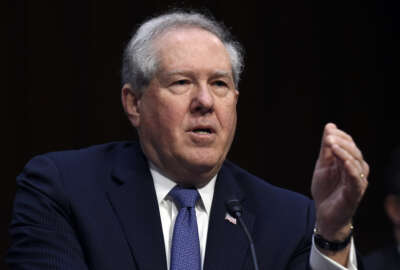
As talent pool wanes, intel community looks to contractors
Intelligence agencies are hiring contractors where government workers were once the norm. This employee deficit is a sign of a larger trend that government and the...
The employee shortage for talented information specialists and scientists in the intelligence community is “too big,” says the director of the National Geospatial-Intelligence Agency Robert Cardillo.
Intelligence’s employee deficit is a sign of a larger trend that government and the Defense Department are unable to attract top talent to their agencies over private industry. It’s a trend that has become more and more of a concern over the past decade and has forced some agencies to turn to contractors for work instead of working in-house.
As DoD becomes less of a leader in technological advances, it’s consistently leaning on industry to use its superior tech power to do its job.
“When you talk IT the [National Reconnaissance Office] brings a lot of things of data from space, so the ground problem is tough. We have to do a lot of ground processing to make that data make sense to analysts,” said NRO director Betty Sapp during the Sept. 8 Intelligence & National Security Summit in Washington. “Commercial has caught up with and surpassed what we need, so we are doing more. … buying commercially available services to do that work for us. We would much rather put our money in the payload capabilities that no one else will do for us, the things we take to space. … but the basic processing power, the computing power is there for us to buy and that is a commercial service that we can take advantage of and we do.”
While outsourcing computer processes may seem pretty benign, other parts of the military and IC have begun to ask industry for help in areas that were solely government.
This week the Air Force announced it has added four contractor flown drones to its fleet of more than 60 run by the service. It plans to add six more over the next two years.
The Air Force’s reasoning for hiring contractors is simple, it doesn’t have enough pilots.
Adding contractors to military and intelligence ranks could create some sticky situations when it comes to legal oversight. That’s not to mention the potential extra cost of hiring a company, instead of providing a service in-house, though some agencies have been able to save money by contracting out simple services.
In recent years DoD and other government agencies have had problems hiring young, tech savvy employees. In 2013, only 7 percent of government employees were under 30. That’s compared to about 19 percent in 1973, an Office of Personnel Management study stated.
Cardillo said he’s noticed the lack of interest in government work from talented people outside the government.
Cardillo mentioned the NGA website.
“There is a button, it says ‘Engage,’ it’s cute because it’s got NGA in the middle of it and all that,” Cardillo said.
That button helps industry partners become part of the NGA to get government experience.
“Likewise, we have talent available that we will send out to industry because we want the same experience. This has been available for about four months now and it’s got spider webs around it. It just has not been leveraged,” Cardillo said.
What’s causing that could be a number of things.
Despite cutting jobs in past years, wages within the private defense sector have increased from an average of $79,000 per year to $94,000 per year, states a February study from Deloitte. The study goes on to read that the private defense sector is poised to add 40,000 jobs in 2016.
Others in DoD think regulations are too strict on hiring private sector talent, especially if they have previous government experience.
In March, Defense Undersecretary for Acquisition, Technology and Logistics Frank Kendall said “revolving door” laws are too stringent and are keeping top talent from entering the public sector.
“It’s too hard to come in [to government] and come back out,” Kendall said. “We used to have very, very talented, the best and brightest people in government. They’d come in from industry for a few years, they’d make a contribution to their country and they’d go back and nobody assumed they were a crook. I think we’ve gone too far trying to protect ourselves from the rare person who is really going to do wrong and we deny ourselves an enormous amount of talent.”
Despite more holistic issues, Cardillo said he is working within his agency to better retention for intelligence analysts.
“We’ve come to understand that the way we have built systems in the past, the way we have developed applications, the way we’ve brought IT to the analysts that stuff won’t work in the future. It’s not agile, it’s not responsive enough,” Cardillo said.
NGA has created rapid feedback teams to fuse intel analysts, data scientists and computer programmers to better work systems and make them more efficient.
Copyright © 2025 Federal News Network. All rights reserved. This website is not intended for users located within the European Economic Area.
Scott Maucione is a defense reporter for Federal News Network and reports on human capital, workforce and the Defense Department at-large.
Follow @smaucioneWFED





